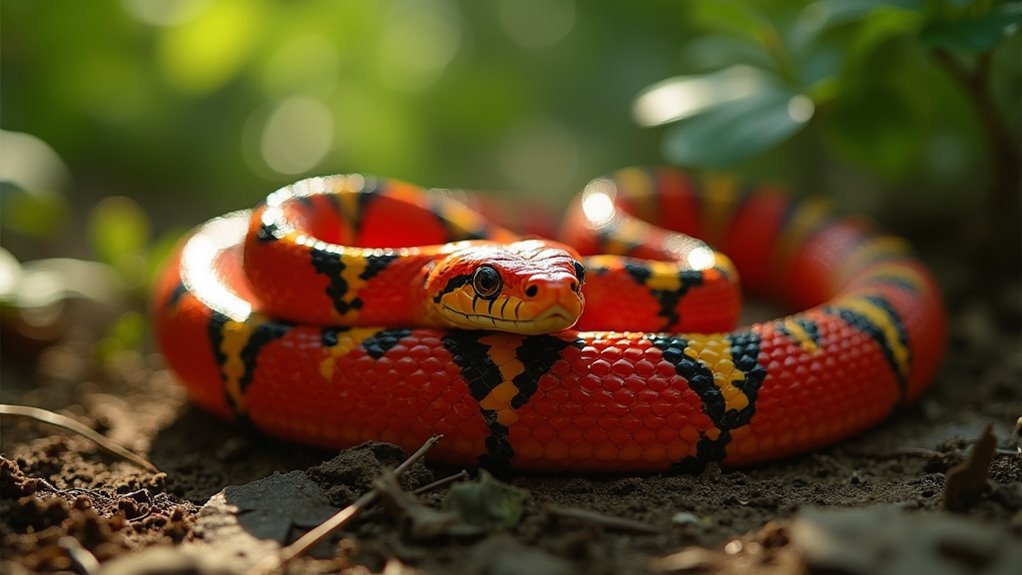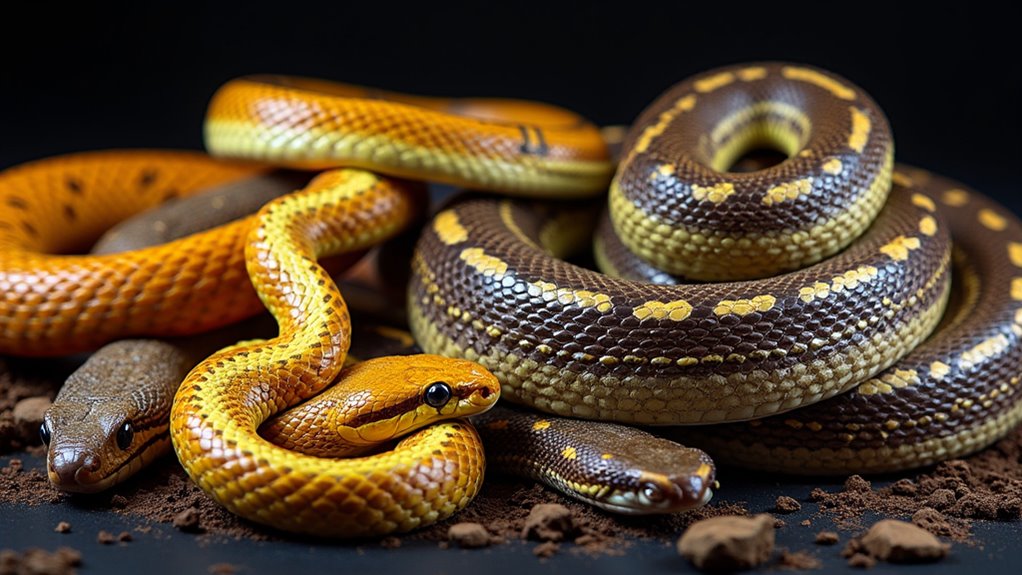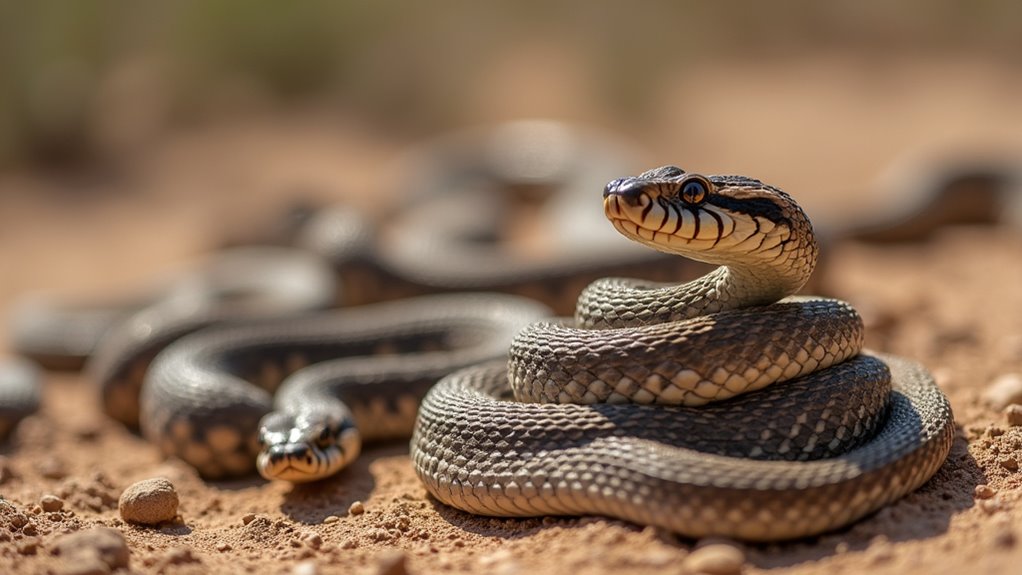Physical Address
304 North Cardinal St.
Dorchester Center, MA 02124
Physical Address
304 North Cardinal St.
Dorchester Center, MA 02124

Killer snakes lurk in Mexico's landscapes, leaving intrepid explorers captivated by their lethal capabilities and the need to understand these remarkable reptiles.
You may not know this, but Mexico is home to some of the world’s most dangerous snakes. From the aggressive Fer-de-Lance to the neurotoxic Coral Snake, these reptiles can pose serious risks. Understanding their venom composition and behaviors is essential for safety and conservation. But what exactly makes these snakes so perilous? Let’s plunge into and explore the key details you need to know.

As one of Mexico’s most dangerous snakes, the fer-de-lance, or Bothrops asper, is a highly aggressive viper that you should be wary of.
This venomous snake can deliver a potent bite, with an average venom yield of 105 mg and a maximum of up to 310 mg – enough to be fatal to humans. Highly sexually dimorphic; females grow larger and have proportionally bigger heads and fangs. The fer-de-lance is found throughout Mexico’s tropical regions, inhabiting lowland rainforests, plantations, and even disturbed areas near human settlements.
Its triangular head, heat-sensing pits, and camouflaged coloration make it a formidable predator, capable of taking down small mammals and birds. Respect this snake’s aggression, and maintain a safe distance if you encounter it in the wild.
Though often mistaken for its more aggressive cousins, the black-tailed rattlesnake is a formidable predator in its own right.
Found throughout the southwestern U.S. and Mexico, this snake thrives in diverse habitats, from grasslands to rocky mountains. Its distinctive black tail sets it apart, while its potent venom is used to quickly subdue prey like small mammals and birds. Venom is primarily hemotoxic, less toxic than western diamondback venom.
While not typically aggressive, the black-tailed rattlesnake will defend itself if threatened, delivering a painful and potentially dangerous bite. Habitat loss and human activity pose risks, but this snake remains an important part of the ecosystem, helping control rodent populations.
Caution is advised when in its range, but this snake generally avoids confrontation if left alone.

Coral snakes are another intriguing species found across Mexico’s diverse landscapes. These brightly-colored reptiles belong to the venomous Elapidae family, which includes cobras and sea snakes.
Throughout Mexico, you’ll find multiple coral snake species, from the Arizona coral snake in the north to the Oaxacan coral snake in the southeast. Coral snakes are generally elusive and fossorial, spending most of their time buried or under leaf litter, while some species are aquatic, living in slow-moving water with dense vegetation. While coral snake bites are rare, their neurotoxic venom can cause respiratory failure if left untreated. Prompt medical attention and antivenom are essential.
To avoid encounters, steer clear of dark, hidden areas where these snakes might lurk. Despite the risks, coral snakes play an important role in their ecosystems, so it’s significant to respect and conserve these unique Mexican reptiles.
Sea snakes are a fascinating and hazardous group of reptiles found in tropical and subtropical waters worldwide, including Mexico’s diverse marine environments. They belong to the subfamily Hydrophiinae within the family Elapidae, known for their potent venom. Highly venomous and belonging to the cobra family, these skilled swimmers use their flattened tails to propel themselves through the water.
While sightings are rare, they inhabit coral reefs, mangroves, and sandy bottoms, preying on fish and eels. Avoid provoking them, and wear protective gear if exploring their habitats. Though attacks on humans are extremely rare, their potent venom can be life-threatening.
Understanding their behaviors and having a plan for potential bites is essential. Conserving their marine ecosystems is critical to protect these unique serpents.

While the venomous sea snakes may grab headlines, Mexico’s diverse colubrid snakes are a lesser-known yet fascinating group.
These rear-fanged colubrids, like the Green Vine Snake, possess mild venom mainly effective on prey. Though rarely dangerous to humans, they inhabit varied habitats from deserts to tropical forests.
Some species, like the banded Lampropeltis mexicana, even exhibit fascinating traits like sexual color dimorphism. Despite limited clinical data, experts consider these snakes low-risk compared to more notorious vipers and coral snakes.
Just avoid traditional first aid methods and seek medical attention if bitten, as no antivenom exists.
With their unique adaptations, Mexico’s colubrids are certainly worth appreciating, even if they lack the fearsome reputation of their venomous counterparts.
Venom composition varies considerably among the different venomous snake species found in Mexico, influenced by a range of intrinsic and extrinsic factors.
Key components include metalloproteinases, phospholipase A2, disintegrins, bradykinin-inhibitory peptides, and C-type lectins, which contribute to varying levels of toxicity.
Venom can also change with a snake’s age, often shifting from myotoxin-rich to more diverse toxin profiles. This venom composition directly impacts how snakes immobilize or kill their prey, tailored to specific prey characteristics.
Understanding these venom complexities is essential for developing effective antivenoms and treating snakebites, which pose serious health risks to humans, including necrosis, renal failure, and respiratory distress.

Protecting yourself from venomous snakes in Mexico requires vigilance and proactive measures.
Identify high-risk habitats like rocky outcrops and avoid dawn/dusk activity when snakes are most active. Stick to established trails and inspect outdoor areas before allowing access.
Wear protective clothing like ankle-covering boots and long pants, and carry a flashlight for nighttime visibility. Never attempt to handle snakes, and keep pets leashed to prevent provoking them.
Rattlesnakes help control rodent and small mammal populations. Remove attractants like rodents, secure hiding spots, and seal entry points around your property.
If traveling to coastal areas like Sinaloa’s beaches, exercise particular caution as some venomous species may be found near tourist destinations.
Memorize venomous species, keep emergency numbers handy, and follow proper first aid should a bite occur.
Mexico’s snake diversity is a double-edged sword – these reptiles are essential to the ecosystem, but can also pose a deadly threat. Stay on your toes, keep your wits about you, and remember: an ounce of prevention is worth a pound of cure when it comes to these slithering denizens of the Mexican wilderness.